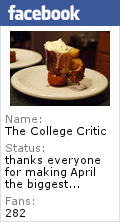No costumes, unless you count chef’s coats; no comic books, unless you count the pamphlets filled with glossy food porn. But at the International Restaurant & Foodservice Show, food enthusiasts join together in a loveable geekdom that rivals Comic-Con. While many of these food enthusiasts come for the infinite bounty of free samples, the show provides an intimate (and sometimes shocking) look into the food service industry.
Although the International Restaurant & Foodservice Show focuses on connecting producers, distributors, and restaurant operators, thousands of “foodies” buy tickets to wander the Javits Center’s airplane hanger hall, engorging themselves on the world’s greatest selection of samples. From charcuterie to chocolate chip cookies, free food is the name of the game; for “buyers” and “sellers,” the samples offer an opportunity to try product and push product, respectively. For visitors not part of the “industry,” the samples offer a substitute for breakfast, lunch, and dinner, a sustained caloric intake diffused over many miniature bites.
Contrary to popular belief, most restaurants in America (even those which purport to serve local, sustainable, organic food) source their ingredients through huge distributors like Sysco. These distributors deliver shipments of raw ingredients and finished products to neighborhood pasta joints and fancy dining destinations alike. What will surprise even those customers who know about the distribution chain, however, is that many “unique,” non-chain restaurants import completed dishes and then serve them as their own. That slice of apple pie with vanilla gelato? House-made? No one leaving the International Restaurant & Food Service Show could sustain that peculiar delusion. Dozens of “bakeries” exist that manufacture bread, dessert, and pastry in bulk. Local coffee shops, diners, and self-impressed restaurants utilize these baking solutions, deceiving their guests. But the illusion of “home-made” extends further, to salads, wraps, whole sandwiches, and entire dishes. Knowing which house the “house-made ravioli” comes from proves impossible—the odds are high though that the restaurant outsources their production to an industrial plant.
Many of these outsourced products taste fine, and I don’t object to restaurants using these services. What I do object to, however, are restaurants that purposefully mislead patrons, and the food elitists who slam chain restaurants and glorify neighborhood joints. Attacking chain restaurants like California Pizza Kitchen, The Cheesecake Factory, and Denny’s is acceptable on certain grounds: the ethics of industrial food production, for example. Yet, vilifying chain restaurants on the basis of serving industrialized food and then proffering the particularized neighborhood restaurant as an acceptable alternative seems hypocritical. Even if neighborhood restaurants opt for Sysco’s more expensive, higher quality prefabricated products, they still engage in the same supply structure and the same ethos of food service. Criticisms of Applebee’s as putting out a “bad product” in comparison to a neighborhood restaurant may be justified, if only because that neighborhood restaurant accepts and absorbs a lower profit-margin. Both typologies of restaurant participate in and validate the outsourcing of food production from the restaurant kitchen to an external, industrial scale fabrication center.
Therefore, the International Restaurant & Foodservice Show actually functions as a reverse Comic-Con—it does not build up or facilitate fantasy, but shatters grand, romantic notions about ordinary, non-chain restaurants. The costume falls off the superhero, revealing the same weak, technocratic body as the villain.
All this theorizing aside, I did try a few outstanding products at the show.
Look out for Ice Age Tea, a beverage brewed from the Eucommiae tree. Called Tochu-cha in Japan, ice age tea resembles Camellia sinensis tea only in general flavor profile—supposedly, ice age tea possesses heightened health benefits. Marketing mumbo-jumbo or scientific reality? The truth probably lies closer to the former, but it’s a pleasant fantasy to entertain.
As many Columbia students know, Ronnybrook Farm sells super-premium dairy products at the weekly greenmarket on Broadway. I tried their peach and strawberry “Drinkable Yogurt”—tangy, satiating, and simultaneously refreshing. Unfortunately, Ronnybrook’s coffee milk barely resembles the Rhode Island original.
Orwasher’s Bakery, located on New York’s Upper East Side, uses the yeast in fermenting grapes to leaven their bread. Their so-called “Artisan Wine Bread” features dense crust and silken, complex crumb. I particularly enjoyed the Levain, which employs Cabernet grape yeast to generate an airy, sour dough.
Like Orwasher’s, Rick’s Picks sells pickles at greenmarkets across New York. Although “The People’s Pickle” tasted unassuming and only vaguely garlicky, Rick’s “Smokra” possesses a formidable kick and noticeable smokiness. Rick’s spicy pickles fare better than their blander relatives: “Mean Beans” and “Hotties” both deliver approachable heat in a vinegary pickle package.
This year’s show featured an array of spectacular charcuterie options. La Quercia, based out of Iowa, makes an admirable coppa piccante: a little spicy, a little salty, and a lot of fatty pork flavor. Located closer to Columbia (where else, the Meatpacking District), Milano’s Suino D’Oro prepares a hot sopressata that combines Calabrian chili, cayenne pepper, and fennel undertones to highlight the pork’s sweetness. Milano’s chicken apple sausage, however, won over my non-chicken-apple-sausage-loving heart. Delicately seasoned with cinnamon, the sasuage erupts with cider and chicken jus with every snappy bite.
Despite the abundance of samples, I am delighted to note that I left at a comfortable level of fullness; after all, I still need to fit into my Comic-Con costume! (Note: I have no intention of going to Comic-Con.)

